

| Monuments (& Events)
related to the "Four Freedoms"
of President Franklin Delano Roosevelt |

 March 4, 1933 - 1st inauguration of President Roosevelt, East Portico, US Capitol, Washington, DC. His address contains the famous line "...the only thing we have to fear is...fear itself."
March 4, 1933 - 1st inauguration of President Roosevelt, East Portico, US Capitol, Washington, DC. His address contains the famous line "...the only thing we have to fear is...fear itself."

 January 20, 1937 - 2nd inauguration of President Roosevelt, East Portico, US Capitol, Washington, DC.
January 20, 1937 - 2nd inauguration of President Roosevelt, East Portico, US Capitol, Washington, DC.

|   January 6, 1941 - Speech by President Roosevelt, Washington, DC (USA). "The Four Freedoms were goals articulated by US President Franklin D. Roosevelt on January 6, 1941. In an address known as the Four Freedoms speech (technically the 1941 State of the Union address), he proposed four fundamental freedoms that people "everywhere in the world" ought to enjoy:
Freedom of speech [from 1st amendment],
Freedom of worship [from 1st amendment],
Freedom from want &
Freedom from fear [from 1st inaugural]." January 6, 1941 - Speech by President Roosevelt, Washington, DC (USA). "The Four Freedoms were goals articulated by US President Franklin D. Roosevelt on January 6, 1941. In an address known as the Four Freedoms speech (technically the 1941 State of the Union address), he proposed four fundamental freedoms that people "everywhere in the world" ought to enjoy:
Freedom of speech [from 1st amendment],
Freedom of worship [from 1st amendment],
Freedom from want &
Freedom from fear [from 1st inaugural]."
|

 January 20, 1941 - 3rd inauguration of President Roosevelt at East Portico, US Capitol, Washington, DC.
January 20, 1941 - 3rd inauguration of President Roosevelt at East Portico, US Capitol, Washington, DC.



| M
U
R
A
L |   1941 - Mural, War Department Building, 21st Street Entrance, Washington, DC (USA). This is now the Harry S. Truman Building of the US Department of State. /// "Employees & guests are greeted by the 50-foot-by-12-foot historic mural "America the Mighty," painted by
Kindred McLeary [1901-1949] in 1942." /// "There is an awesome mural just inside the entrance by one Kindred McLeary called 'Defense of the Four Freedoms' (1941). Apparently it was covered for years by State Department officials who considered it too 'warlike.'" /// Not currently on public view. (Left image is mural study at American Art Museum, Smithsonian Institution.) 1941 - Mural, War Department Building, 21st Street Entrance, Washington, DC (USA). This is now the Harry S. Truman Building of the US Department of State. /// "Employees & guests are greeted by the 50-foot-by-12-foot historic mural "America the Mighty," painted by
Kindred McLeary [1901-1949] in 1942." /// "There is an awesome mural just inside the entrance by one Kindred McLeary called 'Defense of the Four Freedoms' (1941). Apparently it was covered for years by State Department officials who considered it too 'warlike.'" /// Not currently on public view. (Left image is mural study at American Art Museum, Smithsonian Institution.)
|
 December 8, 1941 - United States declares war on Japan one day after the attack on Pearl Harbor.
December 8, 1941 - United States declares war on Japan one day after the attack on Pearl Harbor. 
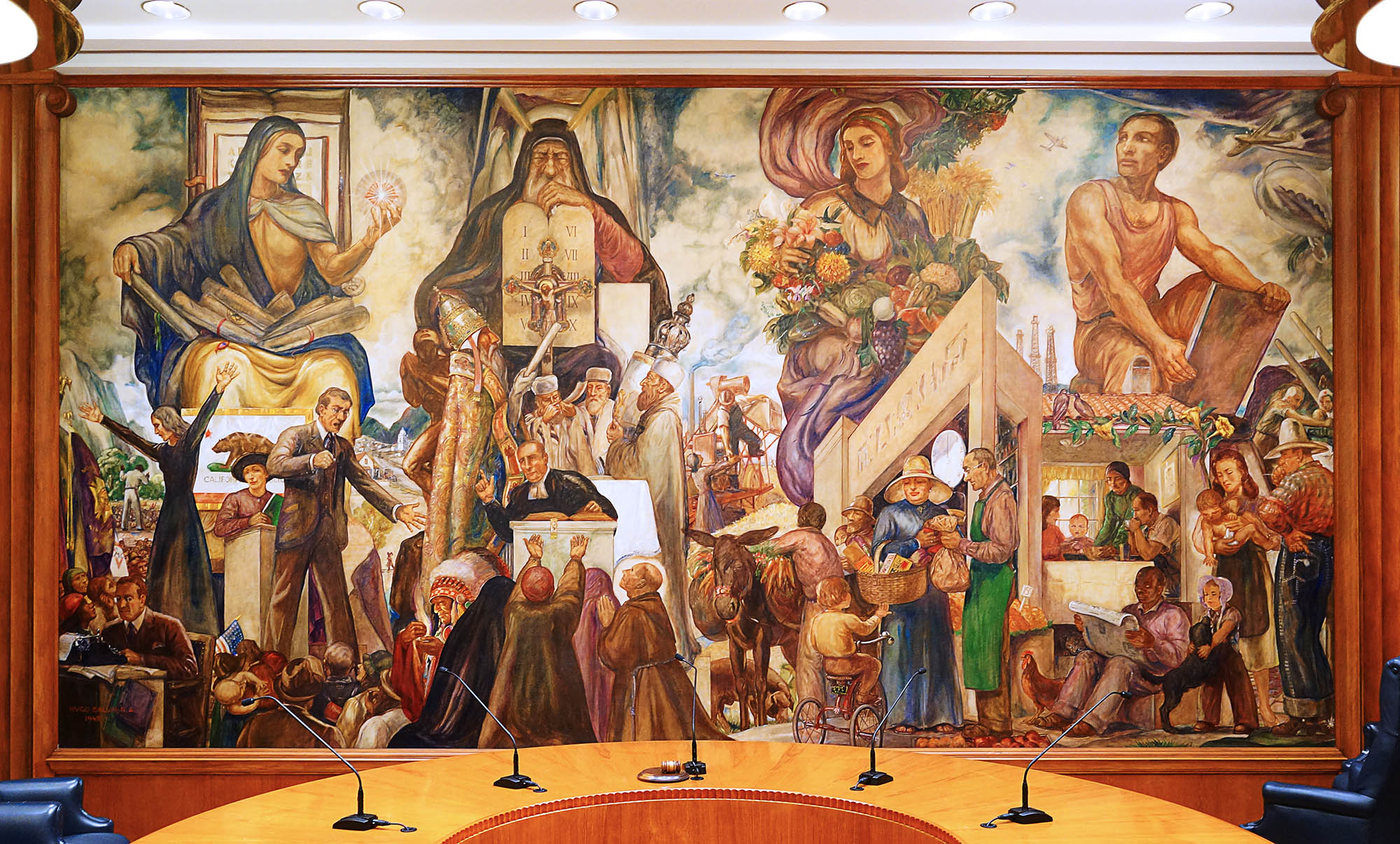
| M
U
R
A
L |   1942 - Artist Hugo Ballin [1879-1956] paints "The Four Freedoms" mural in the Council Chamber of the City Hall of Burbank, California. "The 11 feet by 22 feet mural was inspired by President Franklin Delano Roosevelt’s 1941 "Four Freedoms" speech given at the signing of the Atlantic Charter [sic] and was in place when the City Hall building was dedicated February 12, 1943. It is one of Ballin’s masterworks.
In a letter to Burbank city officials, Ballin noted 'the mission of a mural is to enhance the architecture and to give a harmonious unity to the room in which it is placed. The painter must take into consideration a design which best fits the requirements. Scale, light and color are all equally important and a painter who knows mural painting gives these things paramount consideration.'" 1942 - Artist Hugo Ballin [1879-1956] paints "The Four Freedoms" mural in the Council Chamber of the City Hall of Burbank, California. "The 11 feet by 22 feet mural was inspired by President Franklin Delano Roosevelt’s 1941 "Four Freedoms" speech given at the signing of the Atlantic Charter [sic] and was in place when the City Hall building was dedicated February 12, 1943. It is one of Ballin’s masterworks.
In a letter to Burbank city officials, Ballin noted 'the mission of a mural is to enhance the architecture and to give a harmonious unity to the room in which it is placed. The painter must take into consideration a design which best fits the requirements. Scale, light and color are all equally important and a painter who knows mural painting gives these things paramount consideration.'"
|

|
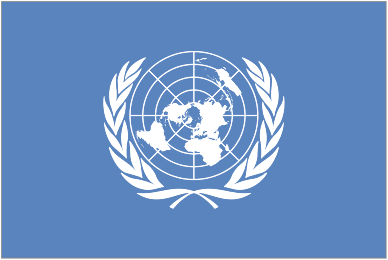 October 1942 - Four Freedoms Flag. Also called the "United Nations Honor Flag." "Was influenced by Roosevelt's Four Freedoms speech, and intended to symbolize the World War II Allies and their goals, as set down in the Atlantic Charter and the Declaration by United Nations. Designed by Brooks Harding in October 1942, and saw some use between 1943 and 1948. Has sometimes been called the first 'United Nations flag' but was never an official organizational flag of the United Nations." October 1942 - Four Freedoms Flag. Also called the "United Nations Honor Flag." "Was influenced by Roosevelt's Four Freedoms speech, and intended to symbolize the World War II Allies and their goals, as set down in the Atlantic Charter and the Declaration by United Nations. Designed by Brooks Harding in October 1942, and saw some use between 1943 and 1948. Has sometimes been called the first 'United Nations flag' but was never an official organizational flag of the United Nations."
|

|
 Date? - "Why We Fight: [Actice] Ella Raines [1920-1988] displays the 'Four Freedoms' flag." Date? - "Why We Fight: [Actice] Ella Raines [1920-1988] displays the 'Four Freedoms' flag."
|


|  February 12, 1943 - Four Freedoms Commemorative Stamp. 1,227,334,200 issued. "The four freedoms became the subject of a 1˘ postage stamp in 1943 (Scott 908). This was not too surprising because Roosevelt was an avid stamp collector who liked to make suggestions to the U.S. Post Office Department about the stamps that should be issued." February 12, 1943 - Four Freedoms Commemorative Stamp. 1,227,334,200 issued. "The four freedoms became the subject of a 1˘ postage stamp in 1943 (Scott 908). This was not too surprising because Roosevelt was an avid stamp collector who liked to make suggestions to the U.S. Post Office Department about the stamps that should be issued."
|


|   1943 - Four Freedoms Memorial, Madison, Florida (USA). "Commissioned by President Roosevelt following his articulation of the 'Four Freedoms' in his 1941 State of the Union Address. This was yet before the participation of the US in World War II. Roosevelt felt that, through the medium of the arts, a far greater number of people could be inspired to appreciate the concept of the Four Freedoms. Created by sculptor Walter Russell later that year, and was dedicated in 1943 before a crowd of 60,000 people at Madison Square Garden in New York City to Colin P. Kelly, one of the first recognized American heroes of World War II. On June 14, 1944, the monument was re-dedicated in Kelly's hometown of Madison, Florida, with a speech by Governor Spessard Holland." /// "A striking sculpture of four angels, their wings unfurled in the wind.
Dedicated to Colin P. Kelly, a B-17 pilot whose plane was shot down just days after Pearl Harbor. " 1943 - Four Freedoms Memorial, Madison, Florida (USA). "Commissioned by President Roosevelt following his articulation of the 'Four Freedoms' in his 1941 State of the Union Address. This was yet before the participation of the US in World War II. Roosevelt felt that, through the medium of the arts, a far greater number of people could be inspired to appreciate the concept of the Four Freedoms. Created by sculptor Walter Russell later that year, and was dedicated in 1943 before a crowd of 60,000 people at Madison Square Garden in New York City to Colin P. Kelly, one of the first recognized American heroes of World War II. On June 14, 1944, the monument was re-dedicated in Kelly's hometown of Madison, Florida, with a speech by Governor Spessard Holland." /// "A striking sculpture of four angels, their wings unfurled in the wind.
Dedicated to Colin P. Kelly, a B-17 pilot whose plane was shot down just days after Pearl Harbor. "
|

|   1943 - "Four Freedoms" Series, Stockbridge, Massachusetts (USA). Four paintings by Norman Rockwell [1894-1978].
"America’s beloved artist completed his famed paintings first published in the Saturday Evening Post magazine [on February 20, February 27, March 6 & March 13]. A special 'Freedom' train carried the originals from coast to coast, thereby selling millions in war bonds." The four paintings have toured widely but now reside at the Norman Rockwell Museum in Stockbridge. 1943 - "Four Freedoms" Series, Stockbridge, Massachusetts (USA). Four paintings by Norman Rockwell [1894-1978].
"America’s beloved artist completed his famed paintings first published in the Saturday Evening Post magazine [on February 20, February 27, March 6 & March 13]. A special 'Freedom' train carried the originals from coast to coast, thereby selling millions in war bonds." The four paintings have toured widely but now reside at the Norman Rockwell Museum in Stockbridge.
|
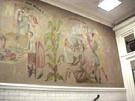
|   1943 - New Jersey muralist Michael Lenson [1903-1972] paints "The Four Freedoms" mural for the Fourteenth Street School in Newark, New Jersey. 1943 - New Jersey muralist Michael Lenson [1903-1972] paints "The Four Freedoms" mural for the Fourteenth Street School in Newark, New Jersey.
|

 January 20, 1945 - 4th inauguration of President Roosevelt at White House, Washington, DC.
January 20, 1945 - 4th inauguration of President Roosevelt at White House, Washington, DC.

 April 12, 1945 - Death of President Roosevelt in Warm Springs, Georgia.
April 12, 1945 - Death of President Roosevelt in Warm Springs, Georgia.

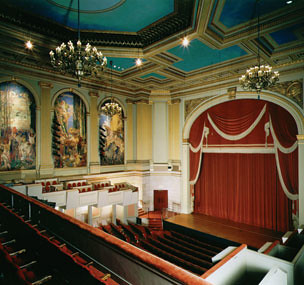


|   June 26, 1945 - War Memorial Building, United Nations Plaza, San Francisco, California (USA). Signing of the United Nations Charter at the United Nations Conference on International Organization by 50 of the 51 original member countries. (Poland signed later). The UN Charter entered into force on October 24, 1945. The auditorium was renamed the Herbst Theatre in 1977. June 26, 1945 - War Memorial Building, United Nations Plaza, San Francisco, California (USA). Signing of the United Nations Charter at the United Nations Conference on International Organization by 50 of the 51 original member countries. (Poland signed later). The UN Charter entered into force on October 24, 1945. The auditorium was renamed the Herbst Theatre in 1977. 
|

|  1946 - Franklin Deleno Roosevelt Commemorative Stamp. Depicts the Four Freedoms. 1946 - Franklin Deleno Roosevelt Commemorative Stamp. Depicts the Four Freedoms.
|

|
  1948 - Muralist Anton Refregier [1905-1979] completes the "History of San Francisco" in the Rincon Center in San Francisco, California. "The original design for panel #27 featured a seven foot head & shoulders portrait of Franklin D. Roosevelt in the central section, but objections were raised that the portrait was too political. On orders from the Public Buildings Administration in Washington, Refregier changed the subject matter. The left section depicts the death of Fascism, the center illustrates the four freedoms, and the right section depicts the founding of the United Nations." 1948 - Muralist Anton Refregier [1905-1979] completes the "History of San Francisco" in the Rincon Center in San Francisco, California. "The original design for panel #27 featured a seven foot head & shoulders portrait of Franklin D. Roosevelt in the central section, but objections were raised that the portrait was too political. On orders from the Public Buildings Administration in Washington, Refregier changed the subject matter. The left section depicts the death of Fascism, the center illustrates the four freedoms, and the right section depicts the founding of the United Nations." 
|
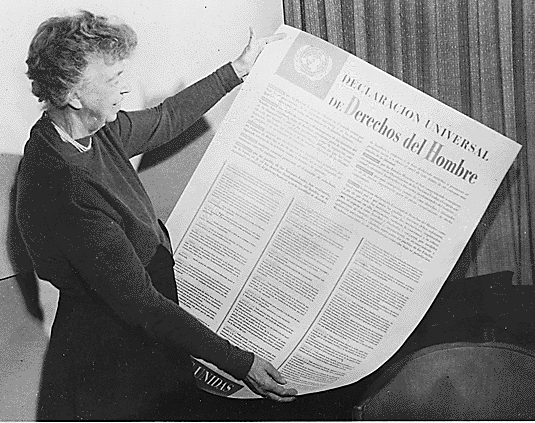
|  December 10, 1948 -
Universal Declaration of Human Rights (UDHR). "Adopted by the United Nations General Assembly at the Palais de Chaillot, Paris (France). The Declaration arose directly from the experience of the World War-II & represents the first global expression of rights to which all human beings are inherently entitled. It consists of 30 articles which have been elaborated in subsequent international treaties, regional human rights instruments, national constitutions & laws. The International Bill of Human Rights consists of the Universal Declaration of Human Rights, the International Covenant on Economic, Social & Cultural Rights, & the International Covenant on Civil & Political Rights & its two Optional Protocols. In 1966, the General Assembly adopted the two detailed Covenants, which complete the International Bill of Human Rights; and in 1976, after the Covenants had been ratified by a sufficient number of individual nations, the Bill took on the force of international law." /// Image shows Eleanor Roosevelt, chair of the committee which negotiated the Declaration. December 10, 1948 -
Universal Declaration of Human Rights (UDHR). "Adopted by the United Nations General Assembly at the Palais de Chaillot, Paris (France). The Declaration arose directly from the experience of the World War-II & represents the first global expression of rights to which all human beings are inherently entitled. It consists of 30 articles which have been elaborated in subsequent international treaties, regional human rights instruments, national constitutions & laws. The International Bill of Human Rights consists of the Universal Declaration of Human Rights, the International Covenant on Economic, Social & Cultural Rights, & the International Covenant on Civil & Political Rights & its two Optional Protocols. In 1966, the General Assembly adopted the two detailed Covenants, which complete the International Bill of Human Rights; and in 1976, after the Covenants had been ratified by a sufficient number of individual nations, the Bill took on the force of international law." /// Image shows Eleanor Roosevelt, chair of the committee which negotiated the Declaration. 
|







 |
 July 3, 1952 - "Expressions of Freedom," First Class Dining Room, SS United States. Four stylized figures (12x16 feet) representing the 'Four Freedoms' by sculptress Gwen Lux [1908-1987]." /// Out of service since 1969, the SS United States is now tied to a pier in Philadelphia, Pennsylvania, awaiting possible restoration as a hotel and/or museum. Many of the ship's fittings were auctioned on October 14, 1984. According to the New York Times, "William D. Wilkinson, director of the Mariners' Museum of Newport News, Virginia, was delighted with his purchases of ''Expressions of Freedom'' by Gwen Lux, the aluminum [sic] sculpture from the main dining room, & the buffet that stood beneath it, for a total of $1,525." /// Bottom three images show the captain's table with "Expressions of Freedom" in background. Lower right image (made by the ship's photographer in September 1967) shows Captain Leroy J. Anexanderson at right and Edward & Vivian Lollis at left. July 3, 1952 - "Expressions of Freedom," First Class Dining Room, SS United States. Four stylized figures (12x16 feet) representing the 'Four Freedoms' by sculptress Gwen Lux [1908-1987]." /// Out of service since 1969, the SS United States is now tied to a pier in Philadelphia, Pennsylvania, awaiting possible restoration as a hotel and/or museum. Many of the ship's fittings were auctioned on October 14, 1984. According to the New York Times, "William D. Wilkinson, director of the Mariners' Museum of Newport News, Virginia, was delighted with his purchases of ''Expressions of Freedom'' by Gwen Lux, the aluminum [sic] sculpture from the main dining room, & the buffet that stood beneath it, for a total of $1,525." /// Bottom three images show the captain's table with "Expressions of Freedom" in background. Lower right image (made by the ship's photographer in September 1967) shows Captain Leroy J. Anexanderson at right and Edward & Vivian Lollis at left.
|
 
 |   Date? -
Four Freedoms Monument, Tremont neighborhood, Cleveland, Ohio (USA). A single column, with one of the Freedoms printed on each side. On top of the column is a sculpture of two hands holding a globe of the Earth." /// "Cared for by the 3 Veterans Posts in Tremont, Post 1, Post 30 and Post 58 and St. John Cantius Church." Date? -
Four Freedoms Monument, Tremont neighborhood, Cleveland, Ohio (USA). A single column, with one of the Freedoms printed on each side. On top of the column is a sculpture of two hands holding a globe of the Earth." /// "Cared for by the 3 Veterans Posts in Tremont, Post 1, Post 30 and Post 58 and St. John Cantius Church."
|

|
  Late 1950's - Artist Mildred Nungester Wolfe [1912-2009] paints four mural panels depicting the four freedoms for a country store in Richton, Mississippi. Those panels now hang in the Mississippi Museum of Art. Late 1950's - Artist Mildred Nungester Wolfe [1912-2009] paints four mural panels depicting the four freedoms for a country store in Richton, Mississippi. Those panels now hang in the Mississippi Museum of Art.
|

|   1958 - "Four Freedoms" by Norman Rockwell, Silverton, Oregon (USA). "On the fiftieth anniversary of their creation [the City of] Silverton commissioned local artist David McDonald to reproduce the famed paintings in mural format. The 'Four Freedoms' still have much to say to us and let us always remember the sacrifices made to keep them alive.
Before you leave kindly step back and let them speak to you - ask yourself. 'What is the status of the Four Freedoms today?'" 1958 - "Four Freedoms" by Norman Rockwell, Silverton, Oregon (USA). "On the fiftieth anniversary of their creation [the City of] Silverton commissioned local artist David McDonald to reproduce the famed paintings in mural format. The 'Four Freedoms' still have much to say to us and let us always remember the sacrifices made to keep them alive.
Before you leave kindly step back and let them speak to you - ask yourself. 'What is the status of the Four Freedoms today?'"
|

|
  About 1958? - "The Four Freedoms," Rotunda Dome, State Capitol, Providence, Rhode Island (USA). "More than 100 feet above the rotunda floor, you will see a magnificent mural [by]
James Allen King [1905-1959], an artist from Scituate, Rhode Island.
Perhaps the greatest disappointment of King's life was that he was unable to complete this great project. Illness made it impossible for King to climb 200 steps each day to get to the top of the dome. He gave the original sketches to other artists (George DeFelice, Robert C. Haun, and Victor Zucchi) who completed his work.
King called his mural design 'The Four Freedoms.' It shows four important aspects of the lives of the early Rhode Island settlers:
THE LAND GRANT - Unlike settlers elsewhere, Roger Williams did not take land from the Indians. He respected the Indians and their way of life. An agreement was made between them, and the Indians granted the settlers land on which to build their homes.
RELIGIOUS TOLERANCE - Rhode Island has always been a safe place to worship freely.
PIONEERING AND THE ORIGINS OF CONSTRUCTION -
The settlers enjoyed the freedom to build their homes.
BEGINNINGS OF INDUSTRY - Settlers began trades that would help them support themselves." /// "The State House dome is the fourth largest, self-supported marble dome in the world.
The largest is St. Peter's Basilica in Rome, the second largest is the Minnesota State Capitol and the third largest is the Taj Mahal in India." About 1958? - "The Four Freedoms," Rotunda Dome, State Capitol, Providence, Rhode Island (USA). "More than 100 feet above the rotunda floor, you will see a magnificent mural [by]
James Allen King [1905-1959], an artist from Scituate, Rhode Island.
Perhaps the greatest disappointment of King's life was that he was unable to complete this great project. Illness made it impossible for King to climb 200 steps each day to get to the top of the dome. He gave the original sketches to other artists (George DeFelice, Robert C. Haun, and Victor Zucchi) who completed his work.
King called his mural design 'The Four Freedoms.' It shows four important aspects of the lives of the early Rhode Island settlers:
THE LAND GRANT - Unlike settlers elsewhere, Roger Williams did not take land from the Indians. He respected the Indians and their way of life. An agreement was made between them, and the Indians granted the settlers land on which to build their homes.
RELIGIOUS TOLERANCE - Rhode Island has always been a safe place to worship freely.
PIONEERING AND THE ORIGINS OF CONSTRUCTION -
The settlers enjoyed the freedom to build their homes.
BEGINNINGS OF INDUSTRY - Settlers began trades that would help them support themselves." /// "The State House dome is the fourth largest, self-supported marble dome in the world.
The largest is St. Peter's Basilica in Rome, the second largest is the Minnesota State Capitol and the third largest is the Taj Mahal in India."
|


|   April 1961 - Four Freedoms Sculpture, Atkinson branch, Milwaukee Public Library, 1960 West Atkinson Avenue, Milwaukee, Wisconsin (USA). By sculptor Dick Wiken [1913-1986]. "An abstract sculpture of hammered green bronze, hammered gold bronze, stainless steel and cast magnesium, colored gold... Each metal represents a different kind of freedom. Freedom from Want (green bronze) includes ornaments of the sun, half hidden by a rain cloud, the germinating seed, sheaf of grain, open book, flash of energy and five loaves and two fishes. Freedom of Religion (of stainless steel) consists of basic symbols of the six major religions (Christianity, Islam, Buddhism, Judaism, Hinduism, and Confucianism). Freedom of Expression (in gold bronze) is ornamented with a flying unicorn, a pajama-clad child with a book riding a flying carpet, a ship at sea, a tree, and a flame of light. Freedom from Fear (cast magnesium) includes a brutalized figure of a man, armed with a club and rock emerging from an atomic explosion mushroom cloud. Also depicted is a broken heart, finger of scorn, the prying eye, the lying tongue, fist and shackle, a listening ear and skull of death" /// Branch library opened in January 1961. April 1961 - Four Freedoms Sculpture, Atkinson branch, Milwaukee Public Library, 1960 West Atkinson Avenue, Milwaukee, Wisconsin (USA). By sculptor Dick Wiken [1913-1986]. "An abstract sculpture of hammered green bronze, hammered gold bronze, stainless steel and cast magnesium, colored gold... Each metal represents a different kind of freedom. Freedom from Want (green bronze) includes ornaments of the sun, half hidden by a rain cloud, the germinating seed, sheaf of grain, open book, flash of energy and five loaves and two fishes. Freedom of Religion (of stainless steel) consists of basic symbols of the six major religions (Christianity, Islam, Buddhism, Judaism, Hinduism, and Confucianism). Freedom of Expression (in gold bronze) is ornamented with a flying unicorn, a pajama-clad child with a book riding a flying carpet, a ship at sea, a tree, and a flame of light. Freedom from Fear (cast magnesium) includes a brutalized figure of a man, armed with a club and rock emerging from an atomic explosion mushroom cloud. Also depicted is a broken heart, finger of scorn, the prying eye, the lying tongue, fist and shackle, a listening ear and skull of death" /// Branch library opened in January 1961.
|
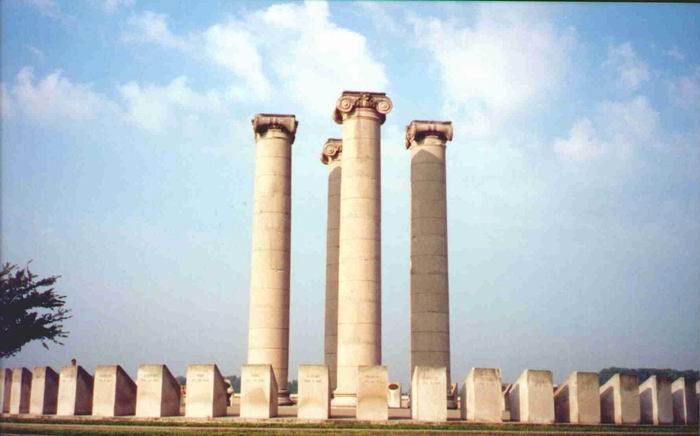 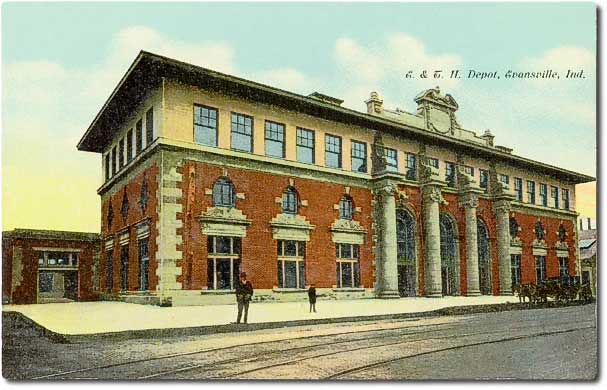

 |   1976 - Four Freedoms Monument, Sunset Park, Ohio River, Evansville, Indiana (USA). Next to "Japanese Pagoda" (qv). A US Bicentennial project. Designed by local engineer Rupert Condict. Has four columns from depot of the former Evansville & Terre Haute Railroad (right image) plus separate stones for each of the 50 states. President Franklin D. Roosevelt [1882-1945] announced the Four Freedoms on January 6, 1941 1976 - Four Freedoms Monument, Sunset Park, Ohio River, Evansville, Indiana (USA). Next to "Japanese Pagoda" (qv). A US Bicentennial project. Designed by local engineer Rupert Condict. Has four columns from depot of the former Evansville & Terre Haute Railroad (right image) plus separate stones for each of the 50 states. President Franklin D. Roosevelt [1882-1945] announced the Four Freedoms on January 6, 1941
|
 |
  1982 - Allyn Cox [1896-1982] completes paintings in the Great Experiment Hall in the US House of Representatives, Washington, DC. Four of the murals depict allegorical figures representing the four freedoms. /// "The central east-west corridor is referred to as the Great Experiment Hall because it chronicles in 16 murals the legislative milestones of three centuries, from the signing of the Mayflower Compact in 1629 to the enactment of women's suffrage in 1920. Thirty-two vignettes complementing the historical scenes are painted at the sides of the murals. In the ceiling 16 medallion portraits are painted in chronological order, and quotations appear above the 16 doorways. The corridor was dedicated in 1982, not long before artist Allyn Cox's death." 1982 - Allyn Cox [1896-1982] completes paintings in the Great Experiment Hall in the US House of Representatives, Washington, DC. Four of the murals depict allegorical figures representing the four freedoms. /// "The central east-west corridor is referred to as the Great Experiment Hall because it chronicles in 16 murals the legislative milestones of three centuries, from the signing of the Mayflower Compact in 1629 to the enactment of women's suffrage in 1920. Thirty-two vignettes complementing the historical scenes are painted at the sides of the murals. In the ceiling 16 medallion portraits are painted in chronological order, and quotations appear above the 16 doorways. The corridor was dedicated in 1982, not long before artist Allyn Cox's death."
|

 1982 - Four Freedoms Award. "An annual award presented to those men & women who have 'demonstrated' an achievement to the principles lined out in the Four Freedoms speech... First presented in 1982 on the centenary of President Roosevelt's birth as well as the bicentenary of diplomatic relations between the United States & the Netherlands... The annual reward is handed out in alternate years in Hyde Park, New York, by the Franklin & Eleanor Roosevelt Institute & in Middelburg, Netherlands, by the Roosevelt Stichting. The choice of Middelburg was motivated by the suspected descendance of the family Roosevelt from Oud-Vossemeer in the municipality Tholen."
1982 - Four Freedoms Award. "An annual award presented to those men & women who have 'demonstrated' an achievement to the principles lined out in the Four Freedoms speech... First presented in 1982 on the centenary of President Roosevelt's birth as well as the bicentenary of diplomatic relations between the United States & the Netherlands... The annual reward is handed out in alternate years in Hyde Park, New York, by the Franklin & Eleanor Roosevelt Institute & in Middelburg, Netherlands, by the Roosevelt Stichting. The choice of Middelburg was motivated by the suspected descendance of the family Roosevelt from Oud-Vossemeer in the municipality Tholen."

|  1994 -
Set of four fifty-cent stamps commemorating the Four Freedoms series of four paintings is issued on the 100th anniversary of Norman Rockwell's birth. 1994 -
Set of four fifty-cent stamps commemorating the Four Freedoms series of four paintings is issued on the 100th anniversary of Norman Rockwell's birth.
|
 
 |
  May 2, 1997 - Franklin Delano Roosevelt's "Four Freedoms," Franklin Delano Roosevelt Memorial, Tidal Basin, Washington, DC (USA). One of the 21 quotes carved into the granite walls of the memorial. Air view of the memorial includes blooming cherry trees on the Tidal Basin. Entry #1160 in the "Peace Movement Directory" by James Richard Bennett (2001). May 2, 1997 - Franklin Delano Roosevelt's "Four Freedoms," Franklin Delano Roosevelt Memorial, Tidal Basin, Washington, DC (USA). One of the 21 quotes carved into the granite walls of the memorial. Air view of the memorial includes blooming cherry trees on the Tidal Basin. Entry #1160 in the "Peace Movement Directory" by James Richard Bennett (2001). 
|
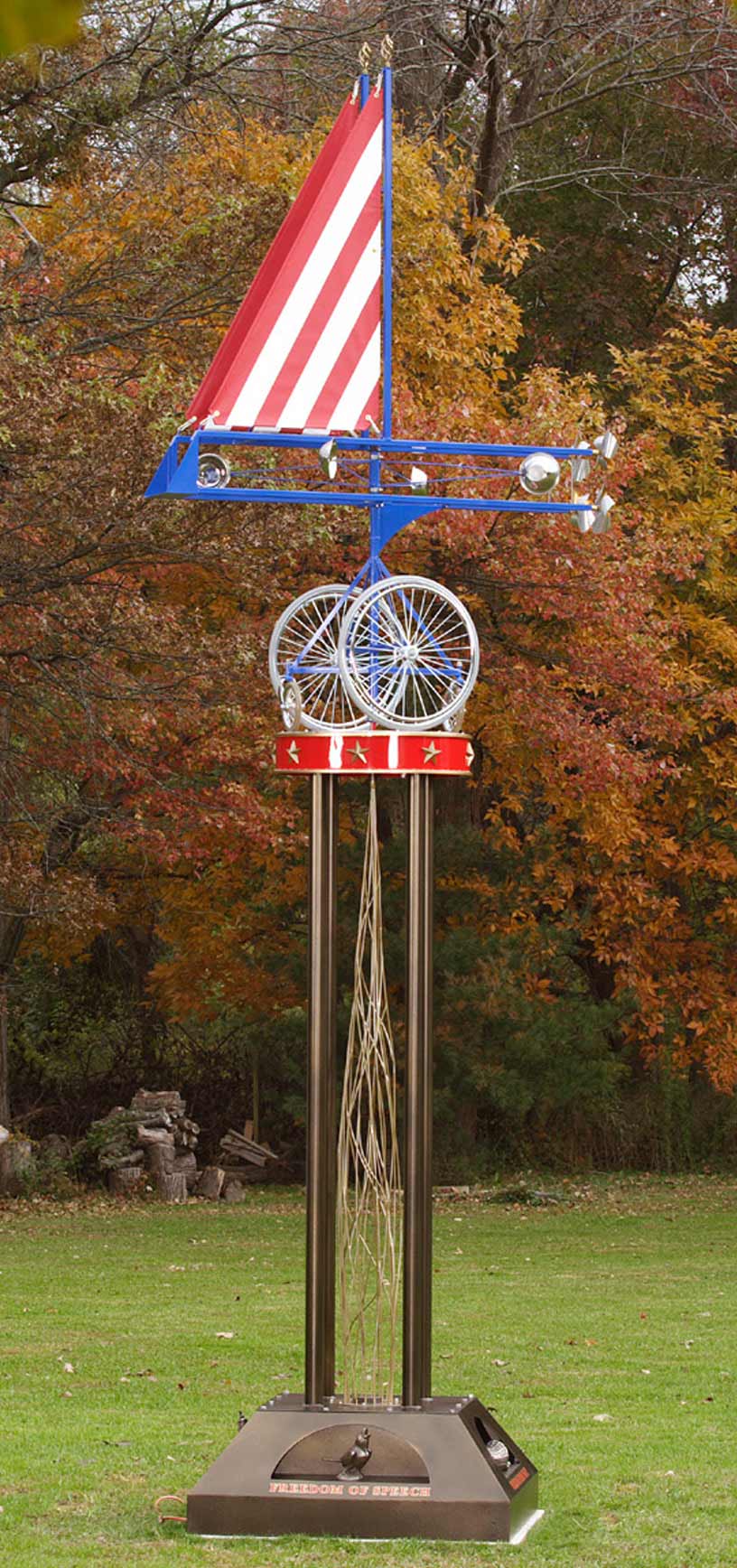

|   November 2006 - Four Freedoms Kinetic Sculpture, Franklin D. Roosevelt Library, Hyde Park, New York (USA). By Henry Philippe Loustau. "Captures the
essence of the Four
Freedoms and the
meaning of American
patriotism through the
sculptor’s use of such
familiar symbols as gold
stars, bold stripes, and the
incorporation of colors
red, white and blue. The
work’s use of the number
four, and its reference to a
wheelchair and a sail set
in constant motion by the
wind, recall the inspiring
and heroic nature of
Franklin D. Roosevelt – a
man who, in spite of his
own struggle with
disability, lifted a
paralyzed nation out of the
despair of the Great
Depression and led us to
victory in the greatest
conflict in history. This sculpture will
travel the world to encourage young people to appreciate
the legacy of freedom as
expressed by President Franklin Delano Roosevelt." November 2006 - Four Freedoms Kinetic Sculpture, Franklin D. Roosevelt Library, Hyde Park, New York (USA). By Henry Philippe Loustau. "Captures the
essence of the Four
Freedoms and the
meaning of American
patriotism through the
sculptor’s use of such
familiar symbols as gold
stars, bold stripes, and the
incorporation of colors
red, white and blue. The
work’s use of the number
four, and its reference to a
wheelchair and a sail set
in constant motion by the
wind, recall the inspiring
and heroic nature of
Franklin D. Roosevelt – a
man who, in spite of his
own struggle with
disability, lifted a
paralyzed nation out of the
despair of the Great
Depression and led us to
victory in the greatest
conflict in history. This sculpture will
travel the world to encourage young people to appreciate
the legacy of freedom as
expressed by President Franklin Delano Roosevelt."
|


|   2008 - "Thoughts on Democracy" Exhibition, Wolfsonian Museum, Florida International University, Miami Beach, Florida (USA). "Elliott Earls’s reinterpretation of Norman Rockwell’s 'Four Freedoms' practically screams. A little girl seems to be crying, her eye bruised, with an American flag in the background and two words framing her figure: 'Liberty Weeps.' The color scheme is red, white & blue, but patriotic pride has been supplanted by sadness.
'She is begging us with her eyes to take responsibility for our actions as a nation,' Mr. Earls said of his creation in an e-mail message. 'And to live up to the greatness embedded in our social fabric by the brilliance of our founding fathers.'
Clearly, Rockwell’s America this is not. It is Sunday afternoon at the Aventura Mall in South Florida, and I’ve come to gauge the impact of a handful of images displayed in 14-foot-high posters near Nordstrom. Culled from a surprising new exhibition at the Wolfsonian Museum,... they are all artists’ responses to Rockwell’s wartime 'Four Freedoms' series.
Sixty artists contributed to the show. But their creations bear little resemblance to the Rockwell paintings, which helped raise $133 million for the war effort in 1943 after the government turned them into posters. There is no folksy man standing up to speak his opinion (exemplifying “Freedom of Speech”), no devout group praying (“Freedom of Worship”) no wholesome family sitting down to a Thanksgiving meal (“Freedom From Want”)." 2008 - "Thoughts on Democracy" Exhibition, Wolfsonian Museum, Florida International University, Miami Beach, Florida (USA). "Elliott Earls’s reinterpretation of Norman Rockwell’s 'Four Freedoms' practically screams. A little girl seems to be crying, her eye bruised, with an American flag in the background and two words framing her figure: 'Liberty Weeps.' The color scheme is red, white & blue, but patriotic pride has been supplanted by sadness.
'She is begging us with her eyes to take responsibility for our actions as a nation,' Mr. Earls said of his creation in an e-mail message. 'And to live up to the greatness embedded in our social fabric by the brilliance of our founding fathers.'
Clearly, Rockwell’s America this is not. It is Sunday afternoon at the Aventura Mall in South Florida, and I’ve come to gauge the impact of a handful of images displayed in 14-foot-high posters near Nordstrom. Culled from a surprising new exhibition at the Wolfsonian Museum,... they are all artists’ responses to Rockwell’s wartime 'Four Freedoms' series.
Sixty artists contributed to the show. But their creations bear little resemblance to the Rockwell paintings, which helped raise $133 million for the war effort in 1943 after the government turned them into posters. There is no folksy man standing up to speak his opinion (exemplifying “Freedom of Speech”), no devout group praying (“Freedom of Worship”) no wholesome family sitting down to a Thanksgiving meal (“Freedom From Want”)."
|
 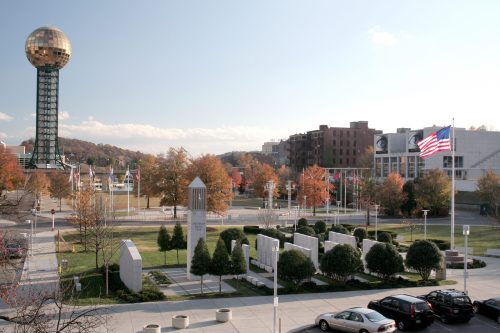

|   November 15, 2008 - Bell Tower, East Tennesse Veterans Memorial, World's Fair Park, Knoxville, Tennessee (USA) . 27-foot high. "On each of the four sides of the tower is inscribed one of the Four Essential Freedoms as enunciated by President Franklin D. Roosevelt in a speech to Congress on January 6, 1941 – freedom of speech and expression, freedom to worship, freedom from want, and freedom from fear." November 15, 2008 - Bell Tower, East Tennesse Veterans Memorial, World's Fair Park, Knoxville, Tennessee (USA) . 27-foot high. "On each of the four sides of the tower is inscribed one of the Four Essential Freedoms as enunciated by President Franklin D. Roosevelt in a speech to Congress on January 6, 1941 – freedom of speech and expression, freedom to worship, freedom from want, and freedom from fear."
|



|   October 17, 2012 - Four Freedoms Park, Roosevelt Island, East River, New York City, New York (USA). Visible from UN Headquarters. "Plans were announced in 1973, but for decades a seemingly endless series of delays left its organizers doubtful of its completion. In fact, until recently, few New Yorkers had even heard of the proposed memorial or knew much about the long, complicated history of its intended site—a 2-mile-long, 800-foot-wide island in the East River... Hewing as closely as possible to the original design of Estonian-born architect Louis Kahn [1901-1974], the four-acre park includes a triangular-shaped lawn, flanked by more than 100 linden trees, that narrows as it approaches the island’s tip. The centerpiece of the memorial is a bronze bust of Franklin Delano Roosevelt based on an earlier work by American sculptor Jo Davidson [1883-1952]. Just beyond the bust lies a space Kahn dubbed the 'Room,' designed to give visitors a place for quiet contemplation. Its 36-ton granite blocks are purposely set just an inch apart from each other, providing a unique perspective of Manhattan through narrow slits." October 17, 2012 - Four Freedoms Park, Roosevelt Island, East River, New York City, New York (USA). Visible from UN Headquarters. "Plans were announced in 1973, but for decades a seemingly endless series of delays left its organizers doubtful of its completion. In fact, until recently, few New Yorkers had even heard of the proposed memorial or knew much about the long, complicated history of its intended site—a 2-mile-long, 800-foot-wide island in the East River... Hewing as closely as possible to the original design of Estonian-born architect Louis Kahn [1901-1974], the four-acre park includes a triangular-shaped lawn, flanked by more than 100 linden trees, that narrows as it approaches the island’s tip. The centerpiece of the memorial is a bronze bust of Franklin Delano Roosevelt based on an earlier work by American sculptor Jo Davidson [1883-1952]. Just beyond the bust lies a space Kahn dubbed the 'Room,' designed to give visitors a place for quiet contemplation. Its 36-ton granite blocks are purposely set just an inch apart from each other, providing a unique perspective of Manhattan through narrow slits." 
|



March 4, 1933 - 1st inauguration of President Roosevelt, East Portico, US Capitol, Washington, DC. His address contains the famous line "...the only thing we have to fear is...fear itself."

January 20, 1937 - 2nd inauguration of President Roosevelt, East Portico, US Capitol, Washington, DC.


January 6, 1941 - Speech by President Roosevelt, Washington, DC (USA). "The Four Freedoms were goals articulated by US President Franklin D. Roosevelt on January 6, 1941. In an address known as the Four Freedoms speech (technically the 1941 State of the Union address), he proposed four fundamental freedoms that people "everywhere in the world" ought to enjoy: Freedom of speech [from 1st amendment], Freedom of worship [from 1st amendment], Freedom from want & Freedom from fear [from 1st inaugural]."

January 20, 1941 - 3rd inauguration of President Roosevelt at East Portico, US Capitol, Washington, DC.




1941 - Mural, War Department Building, 21st Street Entrance, Washington, DC (USA). This is now the Harry S. Truman Building of the US Department of State. /// "Employees & guests are greeted by the 50-foot-by-12-foot historic mural "America the Mighty," painted by Kindred McLeary [1901-1949] in 1942." /// "There is an awesome mural just inside the entrance by one Kindred McLeary called 'Defense of the Four Freedoms' (1941). Apparently it was covered for years by State Department officials who considered it too 'warlike.'" /// Not currently on public view. (Left image is mural study at American Art Museum, Smithsonian Institution.)
December 8, 1941 - United States declares war on Japan one day after the attack on Pearl Harbor.



1942 - Artist Hugo Ballin [1879-1956] paints "The Four Freedoms" mural in the Council Chamber of the City Hall of Burbank, California. "The 11 feet by 22 feet mural was inspired by President Franklin Delano Roosevelt’s 1941 "Four Freedoms" speech given at the signing of the Atlantic Charter [sic] and was in place when the City Hall building was dedicated February 12, 1943. It is one of Ballin’s masterworks. In a letter to Burbank city officials, Ballin noted 'the mission of a mural is to enhance the architecture and to give a harmonious unity to the room in which it is placed. The painter must take into consideration a design which best fits the requirements. Scale, light and color are all equally important and a painter who knows mural painting gives these things paramount consideration.'"

October 1942 - Four Freedoms Flag. Also called the "United Nations Honor Flag." "Was influenced by Roosevelt's Four Freedoms speech, and intended to symbolize the World War II Allies and their goals, as set down in the Atlantic Charter and the Declaration by United Nations. Designed by Brooks Harding in October 1942, and saw some use between 1943 and 1948. Has sometimes been called the first 'United Nations flag' but was never an official organizational flag of the United Nations."

Date? - "Why We Fight: [Actice] Ella Raines [1920-1988] displays the 'Four Freedoms' flag."


February 12, 1943 - Four Freedoms Commemorative Stamp. 1,227,334,200 issued. "The four freedoms became the subject of a 1˘ postage stamp in 1943 (Scott 908). This was not too surprising because Roosevelt was an avid stamp collector who liked to make suggestions to the U.S. Post Office Department about the stamps that should be issued."


1943 - Four Freedoms Memorial, Madison, Florida (USA). "Commissioned by President Roosevelt following his articulation of the 'Four Freedoms' in his 1941 State of the Union Address. This was yet before the participation of the US in World War II. Roosevelt felt that, through the medium of the arts, a far greater number of people could be inspired to appreciate the concept of the Four Freedoms. Created by sculptor Walter Russell later that year, and was dedicated in 1943 before a crowd of 60,000 people at Madison Square Garden in New York City to Colin P. Kelly, one of the first recognized American heroes of World War II. On June 14, 1944, the monument was re-dedicated in Kelly's hometown of Madison, Florida, with a speech by Governor Spessard Holland." /// "A striking sculpture of four angels, their wings unfurled in the wind. Dedicated to Colin P. Kelly, a B-17 pilot whose plane was shot down just days after Pearl Harbor. "


1943 - "Four Freedoms" Series, Stockbridge, Massachusetts (USA). Four paintings by Norman Rockwell [1894-1978]. "America’s beloved artist completed his famed paintings first published in the Saturday Evening Post magazine [on February 20, February 27, March 6 & March 13]. A special 'Freedom' train carried the originals from coast to coast, thereby selling millions in war bonds." The four paintings have toured widely but now reside at the Norman Rockwell Museum in Stockbridge.

1943 - New Jersey muralist Michael Lenson [1903-1972] paints "The Four Freedoms" mural for the Fourteenth Street School in Newark, New Jersey.

January 20, 1945 - 4th inauguration of President Roosevelt at White House, Washington, DC.

April 12, 1945 - Death of President Roosevelt in Warm Springs, Georgia.





June 26, 1945 - War Memorial Building, United Nations Plaza, San Francisco, California (USA). Signing of the United Nations Charter at the United Nations Conference on International Organization by 50 of the 51 original member countries. (Poland signed later). The UN Charter entered into force on October 24, 1945. The auditorium was renamed the Herbst Theatre in 1977.


1946 - Franklin Deleno Roosevelt Commemorative Stamp. Depicts the Four Freedoms.


1948 - Muralist Anton Refregier [1905-1979] completes the "History of San Francisco" in the Rincon Center in San Francisco, California. "The original design for panel #27 featured a seven foot head & shoulders portrait of Franklin D. Roosevelt in the central section, but objections were raised that the portrait was too political. On orders from the Public Buildings Administration in Washington, Refregier changed the subject matter. The left section depicts the death of Fascism, the center illustrates the four freedoms, and the right section depicts the founding of the United Nations."


December 10, 1948 - Universal Declaration of Human Rights (UDHR). "Adopted by the United Nations General Assembly at the Palais de Chaillot, Paris (France). The Declaration arose directly from the experience of the World War-II & represents the first global expression of rights to which all human beings are inherently entitled. It consists of 30 articles which have been elaborated in subsequent international treaties, regional human rights instruments, national constitutions & laws. The International Bill of Human Rights consists of the Universal Declaration of Human Rights, the International Covenant on Economic, Social & Cultural Rights, & the International Covenant on Civil & Political Rights & its two Optional Protocols. In 1966, the General Assembly adopted the two detailed Covenants, which complete the International Bill of Human Rights; and in 1976, after the Covenants had been ratified by a sufficient number of individual nations, the Bill took on the force of international law." /// Image shows Eleanor Roosevelt, chair of the committee which negotiated the Declaration.







July 3, 1952 - "Expressions of Freedom," First Class Dining Room, SS United States. Four stylized figures (12x16 feet) representing the 'Four Freedoms' by sculptress Gwen Lux [1908-1987]." /// Out of service since 1969, the SS United States is now tied to a pier in Philadelphia, Pennsylvania, awaiting possible restoration as a hotel and/or museum. Many of the ship's fittings were auctioned on October 14, 1984. According to the New York Times, "William D. Wilkinson, director of the Mariners' Museum of Newport News, Virginia, was delighted with his purchases of ''Expressions of Freedom'' by Gwen Lux, the aluminum [sic] sculpture from the main dining room, & the buffet that stood beneath it, for a total of $1,525." /// Bottom three images show the captain's table with "Expressions of Freedom" in background. Lower right image (made by the ship's photographer in September 1967) shows Captain Leroy J. Anexanderson at right and Edward & Vivian Lollis at left.



Date? - Four Freedoms Monument, Tremont neighborhood, Cleveland, Ohio (USA). A single column, with one of the Freedoms printed on each side. On top of the column is a sculpture of two hands holding a globe of the Earth." /// "Cared for by the 3 Veterans Posts in Tremont, Post 1, Post 30 and Post 58 and St. John Cantius Church."


Late 1950's - Artist Mildred Nungester Wolfe [1912-2009] paints four mural panels depicting the four freedoms for a country store in Richton, Mississippi. Those panels now hang in the Mississippi Museum of Art.


1958 - "Four Freedoms" by Norman Rockwell, Silverton, Oregon (USA). "On the fiftieth anniversary of their creation [the City of] Silverton commissioned local artist David McDonald to reproduce the famed paintings in mural format. The 'Four Freedoms' still have much to say to us and let us always remember the sacrifices made to keep them alive. Before you leave kindly step back and let them speak to you - ask yourself. 'What is the status of the Four Freedoms today?'"


About 1958? - "The Four Freedoms," Rotunda Dome, State Capitol, Providence, Rhode Island (USA). "More than 100 feet above the rotunda floor, you will see a magnificent mural [by] James Allen King [1905-1959], an artist from Scituate, Rhode Island. Perhaps the greatest disappointment of King's life was that he was unable to complete this great project. Illness made it impossible for King to climb 200 steps each day to get to the top of the dome. He gave the original sketches to other artists (George DeFelice, Robert C. Haun, and Victor Zucchi) who completed his work. King called his mural design 'The Four Freedoms.' It shows four important aspects of the lives of the early Rhode Island settlers: THE LAND GRANT - Unlike settlers elsewhere, Roger Williams did not take land from the Indians. He respected the Indians and their way of life. An agreement was made between them, and the Indians granted the settlers land on which to build their homes. RELIGIOUS TOLERANCE - Rhode Island has always been a safe place to worship freely. PIONEERING AND THE ORIGINS OF CONSTRUCTION - The settlers enjoyed the freedom to build their homes. BEGINNINGS OF INDUSTRY - Settlers began trades that would help them support themselves." /// "The State House dome is the fourth largest, self-supported marble dome in the world. The largest is St. Peter's Basilica in Rome, the second largest is the Minnesota State Capitol and the third largest is the Taj Mahal in India."


April 1961 - Four Freedoms Sculpture, Atkinson branch, Milwaukee Public Library, 1960 West Atkinson Avenue, Milwaukee, Wisconsin (USA). By sculptor Dick Wiken [1913-1986]. "An abstract sculpture of hammered green bronze, hammered gold bronze, stainless steel and cast magnesium, colored gold... Each metal represents a different kind of freedom. Freedom from Want (green bronze) includes ornaments of the sun, half hidden by a rain cloud, the germinating seed, sheaf of grain, open book, flash of energy and five loaves and two fishes. Freedom of Religion (of stainless steel) consists of basic symbols of the six major religions (Christianity, Islam, Buddhism, Judaism, Hinduism, and Confucianism). Freedom of Expression (in gold bronze) is ornamented with a flying unicorn, a pajama-clad child with a book riding a flying carpet, a ship at sea, a tree, and a flame of light. Freedom from Fear (cast magnesium) includes a brutalized figure of a man, armed with a club and rock emerging from an atomic explosion mushroom cloud. Also depicted is a broken heart, finger of scorn, the prying eye, the lying tongue, fist and shackle, a listening ear and skull of death" /// Branch library opened in January 1961.




1976 - Four Freedoms Monument, Sunset Park, Ohio River, Evansville, Indiana (USA). Next to "Japanese Pagoda" (qv). A US Bicentennial project. Designed by local engineer Rupert Condict. Has four columns from depot of the former Evansville & Terre Haute Railroad (right image) plus separate stones for each of the 50 states. President Franklin D. Roosevelt [1882-1945] announced the Four Freedoms on January 6, 1941

1982 - Allyn Cox [1896-1982] completes paintings in the Great Experiment Hall in the US House of Representatives, Washington, DC. Four of the murals depict allegorical figures representing the four freedoms. /// "The central east-west corridor is referred to as the Great Experiment Hall because it chronicles in 16 murals the legislative milestones of three centuries, from the signing of the Mayflower Compact in 1629 to the enactment of women's suffrage in 1920. Thirty-two vignettes complementing the historical scenes are painted at the sides of the murals. In the ceiling 16 medallion portraits are painted in chronological order, and quotations appear above the 16 doorways. The corridor was dedicated in 1982, not long before artist Allyn Cox's death."

1982 - Four Freedoms Award. "An annual award presented to those men & women who have 'demonstrated' an achievement to the principles lined out in the Four Freedoms speech... First presented in 1982 on the centenary of President Roosevelt's birth as well as the bicentenary of diplomatic relations between the United States & the Netherlands... The annual reward is handed out in alternate years in Hyde Park, New York, by the Franklin & Eleanor Roosevelt Institute & in Middelburg, Netherlands, by the Roosevelt Stichting. The choice of Middelburg was motivated by the suspected descendance of the family Roosevelt from Oud-Vossemeer in the municipality Tholen."

1994 - Set of four fifty-cent stamps commemorating the Four Freedoms series of four paintings is issued on the 100th anniversary of Norman Rockwell's birth.



May 2, 1997 - Franklin Delano Roosevelt's "Four Freedoms," Franklin Delano Roosevelt Memorial, Tidal Basin, Washington, DC (USA). One of the 21 quotes carved into the granite walls of the memorial. Air view of the memorial includes blooming cherry trees on the Tidal Basin. Entry #1160 in the "Peace Movement Directory" by James Richard Bennett (2001).



November 2006 - Four Freedoms Kinetic Sculpture, Franklin D. Roosevelt Library, Hyde Park, New York (USA). By Henry Philippe Loustau. "Captures the essence of the Four Freedoms and the meaning of American patriotism through the sculptor’s use of such familiar symbols as gold stars, bold stripes, and the incorporation of colors red, white and blue. The work’s use of the number four, and its reference to a wheelchair and a sail set in constant motion by the wind, recall the inspiring and heroic nature of Franklin D. Roosevelt – a man who, in spite of his own struggle with disability, lifted a paralyzed nation out of the despair of the Great Depression and led us to victory in the greatest conflict in history. This sculpture will travel the world to encourage young people to appreciate the legacy of freedom as expressed by President Franklin Delano Roosevelt."


2008 - "Thoughts on Democracy" Exhibition, Wolfsonian Museum, Florida International University, Miami Beach, Florida (USA). "Elliott Earls’s reinterpretation of Norman Rockwell’s 'Four Freedoms' practically screams. A little girl seems to be crying, her eye bruised, with an American flag in the background and two words framing her figure: 'Liberty Weeps.' The color scheme is red, white & blue, but patriotic pride has been supplanted by sadness. 'She is begging us with her eyes to take responsibility for our actions as a nation,' Mr. Earls said of his creation in an e-mail message. 'And to live up to the greatness embedded in our social fabric by the brilliance of our founding fathers.' Clearly, Rockwell’s America this is not. It is Sunday afternoon at the Aventura Mall in South Florida, and I’ve come to gauge the impact of a handful of images displayed in 14-foot-high posters near Nordstrom. Culled from a surprising new exhibition at the Wolfsonian Museum,... they are all artists’ responses to Rockwell’s wartime 'Four Freedoms' series. Sixty artists contributed to the show. But their creations bear little resemblance to the Rockwell paintings, which helped raise $133 million for the war effort in 1943 after the government turned them into posters. There is no folksy man standing up to speak his opinion (exemplifying “Freedom of Speech”), no devout group praying (“Freedom of Worship”) no wholesome family sitting down to a Thanksgiving meal (“Freedom From Want”)."




November 15, 2008 - Bell Tower, East Tennesse Veterans Memorial, World's Fair Park, Knoxville, Tennessee (USA) . 27-foot high. "On each of the four sides of the tower is inscribed one of the Four Essential Freedoms as enunciated by President Franklin D. Roosevelt in a speech to Congress on January 6, 1941 – freedom of speech and expression, freedom to worship, freedom from want, and freedom from fear."




October 17, 2012 - Four Freedoms Park, Roosevelt Island, East River, New York City, New York (USA). Visible from UN Headquarters. "Plans were announced in 1973, but for decades a seemingly endless series of delays left its organizers doubtful of its completion. In fact, until recently, few New Yorkers had even heard of the proposed memorial or knew much about the long, complicated history of its intended site—a 2-mile-long, 800-foot-wide island in the East River... Hewing as closely as possible to the original design of Estonian-born architect Louis Kahn [1901-1974], the four-acre park includes a triangular-shaped lawn, flanked by more than 100 linden trees, that narrows as it approaches the island’s tip. The centerpiece of the memorial is a bronze bust of Franklin Delano Roosevelt based on an earlier work by American sculptor Jo Davidson [1883-1952]. Just beyond the bust lies a space Kahn dubbed the 'Room,' designed to give visitors a place for quiet contemplation. Its 36-ton granite blocks are purposely set just an inch apart from each other, providing a unique perspective of Manhattan through narrow slits."


